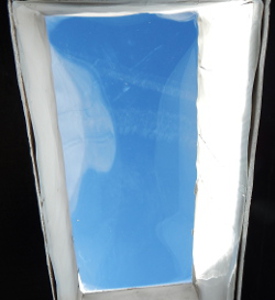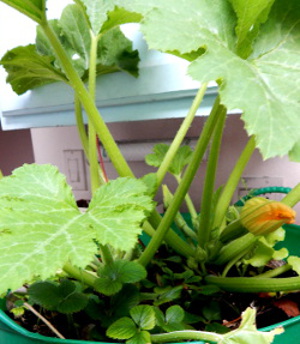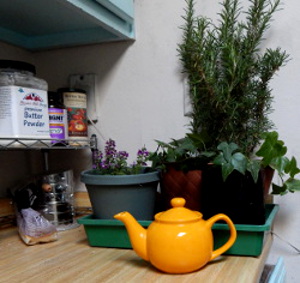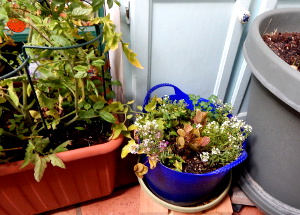
10/25/2015 ~ My new kitchen skylight is clear on clear and replaces a skylight of the same 2×4 size that was translucent rather than clear. I don’t know if the old skylight was double dome.
The interior of the shaft is lined with Orca Grow Film, in a somewhat less than perfect application. The black surrounding the bottom of the skylight is the silver side of sheets of rigic insulation.
The light from this new skylight is vastly brighter than that from my old one, and it’s also a lot brighter than the light from my Solatubes in my living room.
Whether the light will be sufficient to grow veggies, is yet to be seen.
Zucchini and Strawberries

In the hope of a literal Kitchen Garden, I have a three gallon TubTrug on my counter. Its two zucchini squash are sharing the pot with strawberries.
The squash blossom formed outside before the nights got so cold I thought I’d better bring in the plant. The Squash blossom opened on Friday. That’s about two days ago.
I am curious to see if the little squash develops. But, I’m aware that many squash plants set several blossoms and little fruits before they set ones that actually mature.
The strawberry plants in the foreground are also flowering. It would be so great to have fresh strawberries during the winter.
But, my experience last year with indoor strawberries that formed and grew under Solatube in my living room was that they were tasteless. My thought is that they need the sun’s infrared and ultraviolet rays, which Solatube filters out, in order to properly develop.
If that’s true, and it seems to be, then using SunBlock may deprive your body of things you need, beyond the Vitamin D that you miss when you’re in sunshine but wearing SunBlock/SunScreen.
Rosemary, Alyssum, Ivy

Last year my rosemary was in my living room with Solatube and LED lights. It did not thrive. It was fun to water, though, because at being brushed even the least little bit it gives off a strong rosemary fragrance.
I have a great recipe for ruby sweet potatoes and rosemary. I think I should try it with regular canned sweet potatoes, now that I can’t go grocery shopping for fresh ruby sweet potatoes.
Basically, you put the sliced sweet potatoes in a casserole pan with lots of garlic and rosemary. I can’t remember if you’re supposed to blend the garlic and rosemary, but it’s rather likely, otherwise the rosemary would be like little sticks. And, olive oil, of course.
Makes me hungry just thinking of it.
In any case, above is my rosemary on my kitchen counter along with a little pot of flowering alyssum and some ivy I hope will form roots. Ivy is great as an air cleaner. Air cleaning is an asset when you heat with candles, as I do.
Tomato, Alyssum, Capper, Peas

The tomato, upper left corner, is a Cloudy Day. It did well on my deck with partial sun, however that partial sun was direct sunlight following a mostly shaded morning.
The fact there’s a little tomato turning red is not as significant as new flowers would be. The thing is, I should have given my plants new compost after a month of growing, but I didn’t, so they stopped producing as much as when the compost was fresh. That being the case, I don’t know for sure if my Cloudy Day Tomato stopped setting flowers for lack of nutrients, or lack of direct sun.
I’m curious to see if it sets flowers under the skylight in my kitchen.
In the blue pot are alyssum, a small celery plant at the back, and a capper plant in the middle. Cappers are particularly rich in some nutrient I wanted, but it’s been so long since I bought the plant that I can’t remember which nutrient. Once it flowers I’ll have ample time to research which nutrient.
The caper plant is from the Mediterranean area and is said to like sunlight. The first year I had it I accidentally left it in the shade from my fig. It looked very sad after that. So last year I was careful to place it where it would get direct sunlight. It’s leaves are a reddish color, though, which seems to indicate that our High Desert Sunlight was too strong for it and it needed to protect itself.
In the large pot are onions, a thick scattering of Indian Spinach seeds and a few little volunteer peas that came up.
When I tried to grow peas in my living room with Solatube, Incandescent Grow Lightbulbs and LED lights, the peas did not in fact grow. So, I’m very curious to see if they will grow in the light from the clear on clear skylight.
Similarly, Indian Spinach came up from seed in my living room, in the Solatube light, but the plants were like the finest threads you can imagine, nothing like food plants, at all. So, if they grow in my kitchen now, it will be a true testament to the effectiveness of skylight light for growing veg.
7/29/2017 ~ None of the vegetables did very well. It may be that I didn’t water them enough, or it may be that the soil was no longer rich enough to support vegetable production, and I failed to fertilize, or… it could be that there simply was not enough light from the skylight when the winter sun is low on the horizon and not shining directly down and into the skylight.
I did not appreciate, when I had the skylight installed, that it sits on a 2 foot wall, mandated by building codes, to keep the skylight above snow, should there be a lot of snow on the roof in winter. Thus, the height of the wall prevents most direct winter sun from coming in.
Free Trials:
Try Amazon Music Unlimited 30-Day Free Trial


